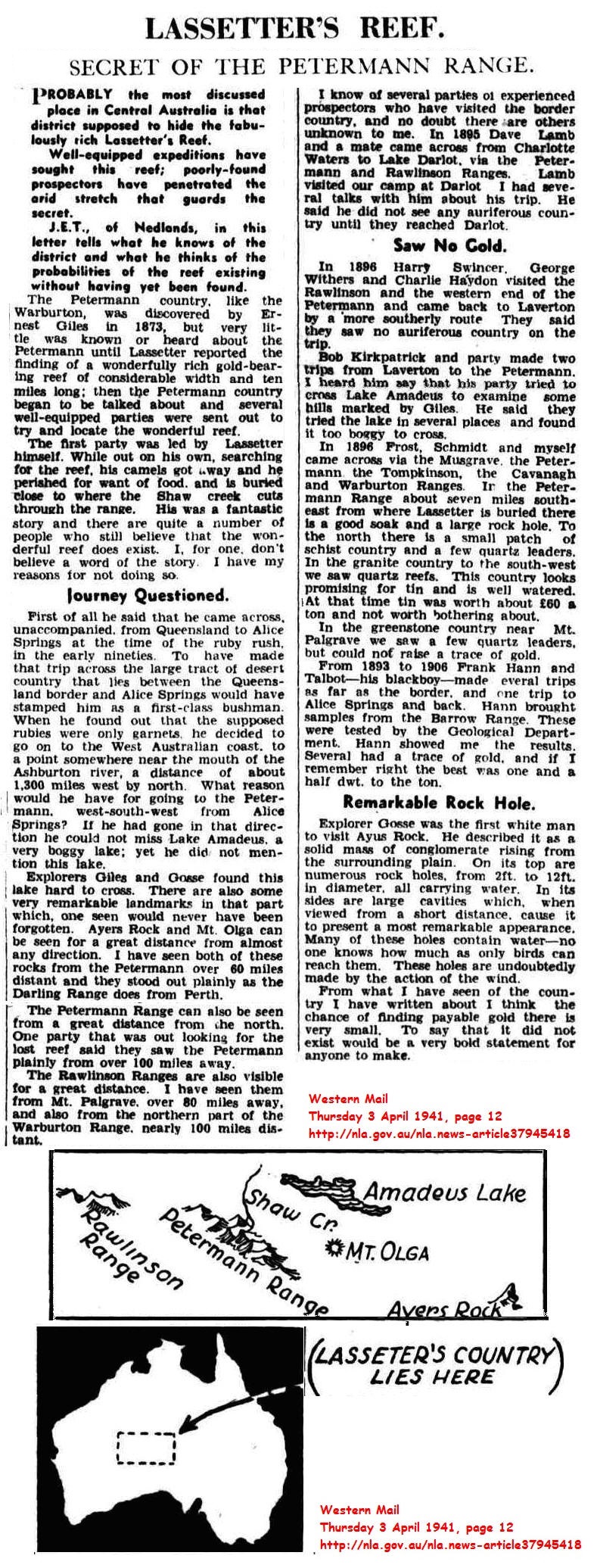| 152A. LASSETER COUNTRY. |
| "Now that Lasseter's country is proved beyond all doubt to be auriferous". |
| Idriess, Ion. L. Lasseter's Last Ride. Endpaper. |
| Depending on the direction of main rumour Lasseter Country lay somewhere in western central Australia or perhaps just over the border in Western Australia, and seems to be more or less centered about the Petermann and Rawlinson Ranges. Idriess first used the term in Lasseter's Last Ride, and the end papers of that book show a mud map with explanatory notes on Lasseter Country. It is a vast area and needs to be to accommodate that enormous gold reef. The boundaries are flexible too, Initially an area of interest at the western end of the MacDonnell Ranges has now expanded to include the Warburton and Liversy Ranges some 350 kilometres to the south west. But some definition should be placed on the bounds of Lasseter country, and it is probably well to do so before the entire continent undergoes a defacto change of name. By generous interpretation, the northern boundary is clearly fixed at Mount Marjorie, correctly known as Mount Liesler. It was from this high point that Lasseter emphatically stated to Blakeley that the reef was 150 miles further south, somewhere in the Petermann Ranges. Blakeley gave Lasseter the option of considering a point 150 miles to the north of Mount Marjorie in the vicinity of known gold country, but Lasseter insisted that his reef lay somewhere 150 miles to the south. For the moment the western boundary can be fixed at Lake Christopher where Lasseter allegedly waited a few days for his bush mate Johansson and left signs in the lake bed for Michael Terry to find in 1932, perhaps confirming Lasseter's presence there. And there is no evidence that Lasseter travelled in any other direction but east, back through the Rawlinson and Petermann Ranges which form the southern boundary of Lasseter Country, contrary to a vague reference in Pastor Albrecht's 1964 letter to the Lutheran Almanac, Lasseter and Johns did not travel to the Mann Ranges on the South Australian border, both men lacked experience and resources to travel so far south. Subject to further investigation it seems that Lasseter traveled no further east than a line from Mount Peculiar to Ayers Rock, although Blakeley makes a snide reference to a well traveled camel pad to Bob Buck's station at Middleton Ponds, alluding to Lasseter's unlikely disappearance to America. Now with reference to an earlier comment about expansive boundaries, an optimistic lateral thinker has rediscovered Lasseter's Country by reversing the map of central Australia and searching in the Tarlton Ranges, north of the Simpson Desert and close by the Queensland border, he has not yet found Lasseter's Reef. The Tanami and Granites goldfields are occasionally included in Lasseter Country and there is a tendency in questionable mining literature and loose histories to attribute any gold discoveries in these areas to Lasseter. In 1974 Idriess pushed the boundary north to include Tennant Creek, discovered by clues to be found in a missing page from Lasseter's Diary, sooner or later Jack Idriess would find gold in Lasseter country. The Warburton Ranges were included in Lasseter country with a flurry of activity in the area in 1932. A fellow by the name of Paddy Whelan reported discovering Lasseter's Reef somewhere in the Liversy Range about 130 miles south of Lake Christopher and 300 miles south west of Illbilla, Whelan's clues to the location of the reef were found in a bottle buried under one of Lasseter's camp fires. Coote became involved in this search, making his second unsuccessful aerial foray to the Centre with the West Centralian Company. Michael Terry dismissed Whelan's discovery as, "awful rot". At about this time C.A.G.E. took out an unusual circular lease of a hundred mile radius centred on three hills about ten miles south west of Lake Christopher. Possum Hill, marks the southern boundary of this lease and being a mere 400 miles north east of Laverton should give Lasseter and Idriess ample opportunity to include some genuine gold in Lasseter Country. By whatever definition Lasseter Country appears to be one of the most gold free areas in Australia.
© R.Ross. 1999-2006 |
